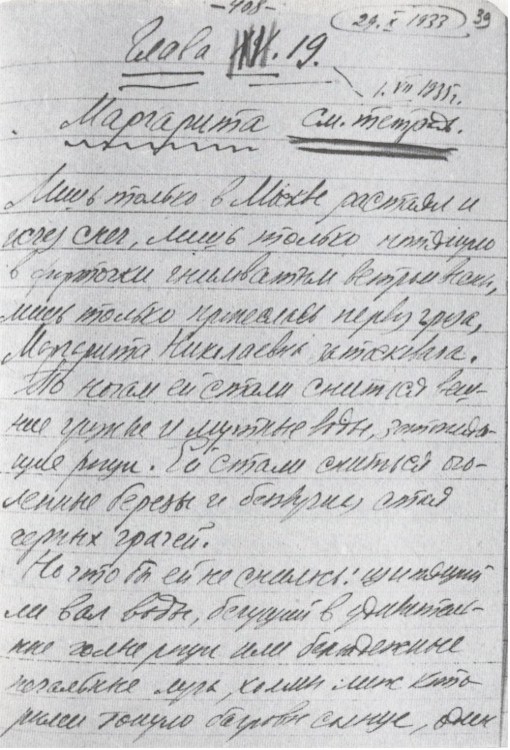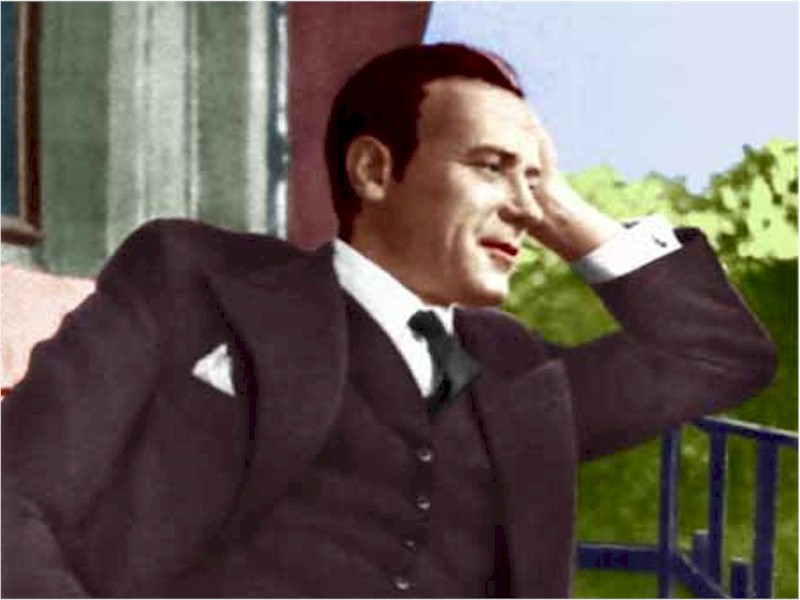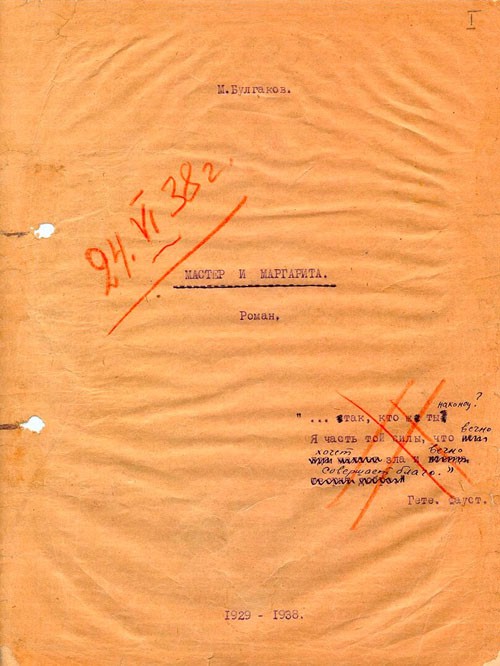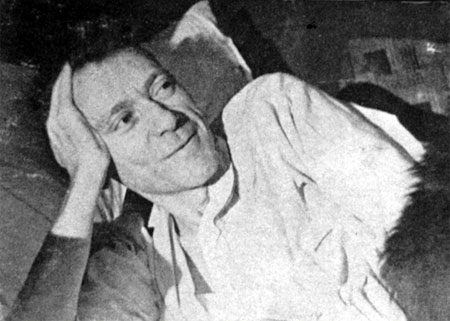Genesis of the novel (continued)
English > The novel > Genesis of the novel (continued)
2. The Engineer's Hoof (1928-1929)
The second version of Bulgakov's The Master and Margarita was entitled Копыто инженера. Черновики романа. Тетрадь 2. 1928-1929 гг. [Kopyto Inzhenera. Chernoviki novel. Tetrad 2. 1928-1929] or The Engineer's Hoof. Concepts for the novel. Notebook 2. 1928-1929. This version also showed traces of other titles that Bulgakov had thought of: Гастроль (Воланда) [Gastrol (Volanda)] or The tour (from Woland), Сын В [Syn V] or The Son of W and Жонглер с копытом [Zhongler s kopytom] or The juggler with the hoof.
Despite the fact that only two chapters are more or less completely preserved in this second notebook, it is clear that it already contains the content that will be further developed in subsequent editions. The two preserved chapters are Евангелие от Воланда [Evangeliye ot Volanda] or The Gospel of Woland, with the Pilate story, and Шестое доказательство [Shestoye dokazatelstvo] or The Sixth Proof, with the beheading of Berlioz.
A very incomplete text of one other chapter has been preserved. It was from the aforementioned Мания фурибунда [Maniya furibunda] or Raging Madness which was presented to the publishing house Nedra.
3. A Scary Saturday Night (1929-1931)
In the spring of 1930 Bulgakov destroyed the first two versions of his novel. It was the period when his plays were completely banned and when he wrote his letter to the Soviet government. He asked to be allowed to go abroad or at least, as he put it: «to get a job in my specialty and to join a theater in the position of director». On October 17, Stalin called him in person and a few weeks later Bulgakov became an assistant director at the Moscow Art Theater MKhAT. In his letter Bulgakov made an allusion to The Engineer's Hoof: «And I personally, with my own hands, threw the draft of a novel about the devil into the fire».
The work in the theater was not very satisfying and Elena Sergeevna Shilovskaya (1893-1970), born Nyurenberg, with whom he had started a relationship in February 1929, had broken up with him at the insistence of her husband. Two thin notebooks entitled Вечер страшной субботы. Черновые наброски к роману. 1929-1931 гг. [Vecher strazhnoy subboty. Chernoviye nabrosky k romanoye. 1929-1931] or A Scary Saturday Night .. Drafts of the novel 1929-1931 date from that time. They contain the preparations for Большой Канцлер [Bolshoy Kantsler] or The Great Chancellor, the next fully written version of the novel.
In these «drafts» Bulgakov dated the Moscow story in the novel for the first time. First he situated the events in Griboedov on Saturday, June 24, 1943. Later he changed that to Saturday, June 24, 1935. This has to do with a prediction by the well-known French pharmacist and astrologer Michel de Nostredame (1503-1566), better known as Nostradamus. You can read more about this in our Annotations per Chapter.
The poet Ryukhin appears and there is a sketch of one of the last chapters, Полет Воланда [Polet Wolanda] or The Flight of Woland, where it is noted: «Lord, help me to end my novel, 1931». In the same excerpt, we read the sentence «You will meet Schubert and the clear mornings», which implies that there is a character present who has not yet been named, but who would become the master. In 1931 the term master was assigned to Woland. It will not be given to Margarita's lover until 1936 when the master becomes the narrator of the last fragments of the Pilate story. The name of Margarita also appears for the first time in this chapter in the sentence «... Margarita cried happily».
Finally, in this version we are also introduced to the demonic characters Fagot and Behemoth for the first time.
4. The Great Chancellor (1932-1934)
Великий канцлер [Belinki kantsler] or The Grand Chancellor is the longest and most complex version of The Master and Margarita. Bulgakov started working on it again in October 1932 during a trip to Leningrad. He had traveled there with Elena Sergeevna, whom he had just married. He started it without his scraps and notes. «I know it by heart», he said to Elena Sergeevna. That would become a phrase that is also used by the master in the final version of the novel.
The work would last, with many interruptions, until the autumn of 1936. New possible titles emerged such as Подкова иностранца[Podkova inostrantsa] or The Stranger's Horseshoe and Театральный роман [Teatralny roman] or Theatrical novel.
In one of the 1933 variants, the hospitalized Ivanushka asked for a Gospel, after which Woland sat down next to his bed at night to tell him his Gospel. But in the end, the unnamed poet became the author of a novel that matched The Gospel of Woland, and the biblical story began to be fragmented. Pieces of it were removed from the second chapter, and moved to chapters 11 and 16. Other interventions also began to evolve towards what the novel would ultimately look like: the love between the master and Margarita, the departure of Margarita to the Sabbath, and the reappearance of the master.
Some chapters were written in Leningrad in June 1934. The manuscripts of the time still show how the writer hesitated about the sequence of the scenes and how he still struggled with the ending, especially with regard to the reward the master should receive at the end of the last journey. The outcome was first described in July 1936 in Chapter 37 entitled The Last Flight.
The draft version was finished in October 1934. The novel had 37 chapters.
5. Fantastic novel (1934-1936)
Although the novel was «finished», Bulgakov still rewrote several pieces until the summer of 1936. The result was a manuscript entitled Фантастический роман. Главы, дописанные и переписанные 1934-1936 гг [Fantastichesky roman. Glavi, dopisanniye i perepisanniye 1934-1936] or Fantastic novel. Chapters added and rewritten in 1934-1936. In the margin of the title page was a note, written on October 30: «To be finished before dying».
he master became a highly autobiographical figure - Bulgakov wrote a text which met the same fate as the one written by his hero.
6. The Golden Spear (1936-1937)
Late 1936, early 1937 Bulgakov started a new version of his novel with the title Золотое копье [Zolotoye kopye] or The Golden Spear.
t only counted ninety pages, and the story about Jesus and Pilate moved back to the second chapter.
7. The Prince of Darkness (1937)
Still in 1937 comes a new version with a new title on the front page: Князь тьмы. Роман. [Knyaz tmy. Roman.] Or The Prince of Darkness. Novel.
It counted 299 pages and Bulgakov mentioned 1928-1937 as the date. The political dimension was less pronounced compared to previous versions. Apparently Bulgakov had partially censored the text himself because he hoped to be able to officially publish the finished novel. It is doubtful he really believed in the possibility, but at least he wanted to finish the novel as soon as possible.
The text ended abruptly in the thirteenth chapter, in the midst of the master's dialogue with Ivan in Doctor Stravinsky's clinic: «The guest didn't mention her name, but said the woman is smart, great…»
8. The Master and Margarita (1937-1938)
In the autumn of the same year Bulgakov started on a next version, which was also dated 1928-1937. He would work on it until the spring of the following year.
The final title was now found. The story of the devil would become Мастер и Маргарита [Master i Margarita] or The Master and Margarita. Reality and fiction were intertwined into the result we know today, and on May 23, 1938, the last handwritten version was ready, in six thick notebooks with thirty chapters. The last chapter, entitled Прощение [Proshenye] or Forgiveness, had undergone a major change. Woland sent the master to the fifth procurator of Judea to join him and find peace there.
First typewritten version (1938-1939)
On May 26, 1938, Bulgakov finally began to dictate his text to his sister-in-law Olga Sergeevna Boshkanskaya (1891-1948) - «with her unique perseverance», but meanwhile he kept changing many things. The work was enormous and the pressure was high. In his letters to Elena Sergeevna, who in the meantime stayed in a dacha in Lebedyan with her son Serjozhka, Bulgakov described in an often funny way his collaboration with Olga, who was also the secretary of Vladimir Nemirovich-Danshenko (1859-1943), one of the two founders of the Moscow Art Theater MKhAT. But on June 2, 1938, it apparently began to weigh, because then he wrote: «I must end the novel! Now! Now!». On June 24, 1938, Olga Sergeevna's work was finished.
But Bulgakov continued to make changes to the typed version. One of the changes is worth mentioning. On May 14, 1939, Matthew Levi appeared with the announcement that «the master had not deserved light, but peace». And so he no longer went on the road to the moon with his hero, the fifth procurator of Judea.
During this period Bulgakov, who did not see how the novel would ever be published, began to hand out long extracts of his novel to his friends.
Last changes (1939-1940)
On October 4, 1939, Bulgakov was fatally ill and almost blind, but he still began to dictate the last changes. A work that would be interrupted at the beginning of the second part, Berlioz's funeral. Some additions that clearly had to do with the biographical circumstances date from that period. The piece about Doctor Kuzmin is an example of this. This also applies to the extensions of chapter 19, Margarita, and to the first sentence of the last chapter: «Gods, gods my! How sad is the evening earth».
On February 13, 1940, Bulgakov worked on his novel one last time, and on March 10 he died, giving the novel its final form.
Share this page |
Annotations per chapter

In this section are explained, per chapter, all typical notions, names of people and places, quotations and expressions from the novel with a description of the political, social, economical and cultural context.



